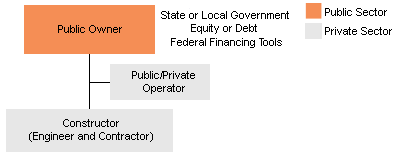

Detailed description of the graphic
Public Owner (state or local government, through equity or debt) executes a single contract to private Constructor (engineer and contractor) and Public/Private Operator (architectural/engineering services)
Design-build is a project delivery method that combines two, usually separate services into a single contract. With design-build procurements, owners execute a single, fixed- fee contract for both architectural/engineering services and construction. The design-build entity may be a single firm, a consortium, joint venture or other organization assembled for a particular project.
With design-build delivery, the design-builder assumes responsibility for the majority of the design work and all construction activities, together with the risks associated with providing these services for a fixed fee. When using design-build delivery, owners usually retain responsibility for financing, operating and maintaining the project.
| Own | Conceive | Design | Build | O&M | Financial Responsibility | |
|---|---|---|---|---|---|---|
| Design Build | Public | Public | Private by fee contract | Public | Public | |
With design-build procurement, the owner must complete a certain amount of preliminary engineering and project definition in order to be able to prepare bid documents. While the level of definition is not fixed, experience in the highway sector suggests that preliminary design efforts of 10 to 15 percent completion are usually adequate. A project that is too advanced (for example, fully designed) may be unattractive since there will be minimal opportunity for the private sector to apply innovative methods to reduce cost and schedule. A project that still is at an early stage with unanswered questions regarding scale, alignment and other project features will be difficult to structure on a design-build basis because the potential private sector partner will be unable to reliably assess schedule and costs.
Customary practice with design-build procurements is to rely upon best value. This approach, which is encouraged by Federal guidelines, takes into account both the technical capabilities and qualifications of the design-build team, and cost. There is no universally accepted approach for determining best value, with the request for proposal usually specifying the relationship between technical factors and price.
Greater opportunity for applying the design-build contracting method to projects has been facilitated through recent legislative changes in SAFETEA-LU and MAP-21.
Section 1503 of SAFETEA-LU eliminated the $50 million floor on the size of contracts that can use design-build contracting without special approval. Section 1503 also directed the Secretary to revise the regulations applicable to design-build contracts to permit transportation agencies to proceed with certain actions relating to design-build contracts, prior to receipt of final NEPA approval. Specifically, the regulations may not require compliance with section 102 of the National Environmental Policy Act of 1969 prior to any agency: (a) issuing requests for proposals; (b) proceeding with awards of design-build contracts; or (c) issuing notices to proceed with preliminary design work under design -build contracts. These modifications have allowed private sector partners to be involved in the project definition process prior to NEPA approval.
Pursuant to Section 1503, FHWA issued a final rule on design-build contracting regulations in the August 17, 2007 issue of the Federal Register.
MAP-21 permits a greater Federal funding share (normally 90 percent for Interstate Highway projects and 80 percent for other projects) for projects that use some method of accelerated project delivery, which includes design-build contracts. Section 1304 of MAP-21 allows the Federal funding share to increase by up to 5 percent of the total project cost, subject to the limit of 10 percent of the combined apportionments of the state under the National Highway Performance Program, Surface Transportation Program, and Metropolitan Planning.
Current Design-Build Practices for Transportation Projects
Design Build Institute of America Publications
50-State Survey of Transportation Agency Design-Build Authority
Prepared by Brandon Davis and Nancy Smith of Nossaman,
LLP, this survey identifies legislation permitting agencies to enter into design-build
contracts and exclusive development agreements to develop transportation infrastructure.
The survey reflects legislative developments through March 2009.
FHWA Design-Build
Effectiveness Study Final Report
This report
was prepared in response to Section 1307(f) of TEA-21. It is a comprehensive
assessment of the design-build approach to project delivery involving both program-level
and project-specific data from a sample of projects developed under the SEP-14 Program.
The report informs current and prospective users of alternative project
delivery approaches about the relative merits of design-build versus the more traditional
design-bid-build contracting process and the challenges and opportunities associated
with implementing a design-build program.
